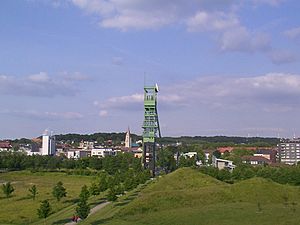Castrop-Rauxel facts for kids
Quick facts for kids
Castrop-Rauxel
|
|||
|---|---|---|---|

Zeche Erin, shaft 7
|
|||
|
|||
| Country | Germany | ||
| State | North Rhine-Westphalia | ||
| Admin. region | Münster | ||
| District | Recklinghausen | ||
| Subdivisions | 15 | ||
| Elevation | 98 m (322 ft) | ||
| Population
(2022-12-31)
|
|||
| • Total | 73,795 | ||
| Time zone | CET/CEST (UTC+1/+2) | ||
| Postal codes |
44575–44581
|
||
| Dialling codes | 02305, 02367 (Henrichenburg) |
||
| Vehicle registration | RE | ||
| Website | www.castrop-rauxel.de | ||
Castrop-Rauxel is a town in the western part of Germany. It is located in the state of North Rhine-Westphalia. This town is part of the Ruhr area, which is a large urban region. About 78,000 people live in Castrop-Rauxel. It is known for its history related to industry and mining.
Contents
What is Castrop-Rauxel like?
Castrop-Rauxel is a medium-sized town. It combines older parts with newer areas. You can find historic buildings alongside modern shops and homes. The town has a mix of green spaces and developed areas. This makes it a pleasant place to live and visit.
Where is Castrop-Rauxel located?
The town is in the Ruhr area of Germany. This region is in the state of North Rhine-Westphalia. The Ruhr area used to be a big center for coal mining and steel production. Today, it has changed a lot. It is now home to many different industries and cultural sites. Castrop-Rauxel is part of this exciting transformation.
How many people live there?
Around 78,000 people call Castrop-Rauxel home. This number makes it a lively community. The people living here come from various backgrounds. They contribute to the town's unique culture.
History of Castrop-Rauxel
The town of Castrop-Rauxel was formed from several smaller communities. It officially became one town in 1926. Before that, the areas had their own long histories. For example, Castrop was a market town. Rauxel was a smaller settlement.
Why is the Ruhr area important?
The Ruhr area was once the industrial heartland of Germany. It had many coal mines and steel factories. This history shaped towns like Castrop-Rauxel. Even though many mines have closed, their legacy remains. You can still see old mining towers, like the one from Zeche Erin, which are now landmarks.
Life in Castrop-Rauxel
Life in Castrop-Rauxel offers a balance. It has the feel of a smaller town but with the benefits of a larger city nearby. Residents enjoy local parks and community events. There are also good connections to bigger cities in the Ruhr area.
What can you do there?
The town has various things to do. You can visit local parks for outdoor activities. There are also sports clubs and cultural centers. The town hall and other public buildings are important places. They help manage the town's daily life.
Local government and leadership
Like all towns, Castrop-Rauxel has a local government. This government helps run the town. It makes decisions about schools, roads, and public services. The mayor, Johannes Beisenherz, leads the town's administration. He works with the town council to serve the community.
Images for kids
-
Castrop Rauxel Square, Wakefield, named after its twin town
See also
 In Spanish: Castrop-Rauxel para niños
In Spanish: Castrop-Rauxel para niños







